
Part II: How Companies Can Use Social Media to Influence Building Professionals
Overview: Effective strategies manufacturers can use to harness the power of social media.
The recently published Accountability Information Management Inc. report entitled “Part 1: How Building Professionals Use Social Media” indicated that 72% of building professionals use social media for their jobs – a fact that demonstrates how important social media is becoming in the building industry The report went on to identify how architects, designers, engineers and facility professionals use social media and what social platforms they most often use. Part II of this social media research will discuss how companies can improve their social media programs to increase their reach to building professionals well as maximize exposure and engagement.
Social Media is Becoming More Important to B2B Marketing
Reaching active and busy building professionals is not easy and requires a multi-media approach. With more and more professionals working in “outside” office locations, companies need to use a variety of media to ensure messages are getting to their target audience and social media is becoming an increasingly important part of the media mix. According to recent research by Zippia,[1] a U.S. career research company, 77% of workers use social media at work – but only 27% report using social media specifically for activities or information related to their job. In addition, 36% of companies indicated they block employees from using social media at work. So what does this mean for companies who want to reach building professionals with information on their products or services? It means they need to clearly define their target audience and provide valuable and relevant information they can use in their jobs.
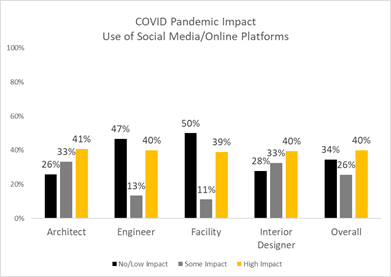 Not surprisingly, AIM’s social media research indicated that the COVID pandemic had a strong impact on building professional’s use of social media. Sixty-six percent of professionals surveyed indicated COVID had either some or a high impact on their use of social platforms. While the use of social media for work-related activities is constantly changing, it is clearly here to stay. Companies who want to reach building professionals will need a well structured and appropriate strategy to connect with them.
Not surprisingly, AIM’s social media research indicated that the COVID pandemic had a strong impact on building professional’s use of social media. Sixty-six percent of professionals surveyed indicated COVID had either some or a high impact on their use of social platforms. While the use of social media for work-related activities is constantly changing, it is clearly here to stay. Companies who want to reach building professionals will need a well structured and appropriate strategy to connect with them.
As AIM reported in Part 1 of their social media report, the frequency of use and type of social media used can differ by the type of building professional. This means that the social media strategy for reaching architects may differ from the plan to reach facility managers. For example, architects may relate more to how a product or service can enhance or benefit the overall design of their project while facility managers are more interested in how easy the product is to maintain or its overall durability under specific conditions. More often architects are interested in more technical details while facility managers may want practical information on the product use and applications. It is extremely important for a manufacturer’s social media strategy to provide content that is reliable and to the target audiences.
A Successful Social Media Platform Needs to be Useful & Relevant to the Target Audience
AIM’s social media research indicated that building professionals found the information they used on social media to be fairly useful and relevant to their jobs. On a scale of 1 to 5, where 1 equals not at all and 5 equals extremely reliable or useful, building professioanls rated social media a 3.1 and 3.2 respectively. In open-ended comments, building professionals indicated social media provides ideas and inspiration for projects they are working on and can also give them insight and examples on how a particular product is used in a project. However, building professionals also stated not ALL information is “good.” You have to check the source of the information and also fact check what the information itself. For example, some building professionals indicated YouTube and LinkedIn seemed to be more reliable and informative than other sources.
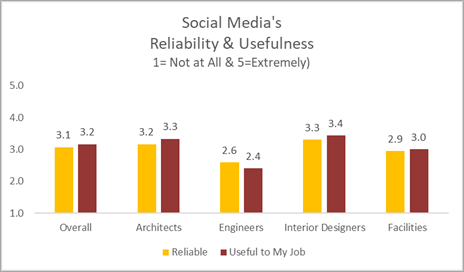 Sample Verbatim Comments:
Sample Verbatim Comments:
- Always fact check info and content.
- I try to find the best resources I can find.
- LinkedIn is probably the most informative and reliable at this time.
- Unfortunately, there is bad information floating around out there.
- You have to know the provider to have trust in what you are using/viewing.
- You must learn to discriminate what you need.
- It has been growing with information.
- Digital access and sharing has been helpful this year.
Using content that can be useful and relevant to a persons’ work is not a new concept, but the ease of posting and using social media has generated an abundance of information—some accurate and relevant,some not so much. According to a podcast presented by Smart Buildings Materials Marketing[2], the most important way to engage architects is to help them solve problems. In addition, they point out that architects need and want technical details and that companies need to provide many avenues for architects to learn about their products or services. Again, social media is just one channel for keeping building professionals engaged with a product or service. If a company chooses to use social media, they need to formulate a strategy for presenting the most relevant information in a format that their target audience needs and wants.
Content is King
To understand more about how building professionals are using social media and what type of content and information professionals are looking for, AIM’s research asked respondents in open-ended questions about what they felt were the advantages and disadvantages of social media. Overall, most often building professionals thought the advantage of using social media was that it was able connect with large audiences. It also was viewed as a vehicle that provided awareness, exposure and recognition for their firms/projects. In looking at these advantages, manufacturers should focus their social media efforts on presenting their products in use in different project applications. Building professionals like to see products, materials and services in a particular application and are interested in details on how the product/material was helpful in solving the project needs/objectives.
Other advantages of social media that building professionals listed was it is easy to use and quick. It also provides networking opportunities and connections. For companies interested in reaching building professionals through social media, this means messaging should be concise, and easy to understand and access. Social media communications should contain direct links to products in use and/or contact information. Since networking is a key benefit of social media, it is important to include the architect/designer or facility that was using a particular product showcased in the social media. This is a great way to get the target audience engaged.
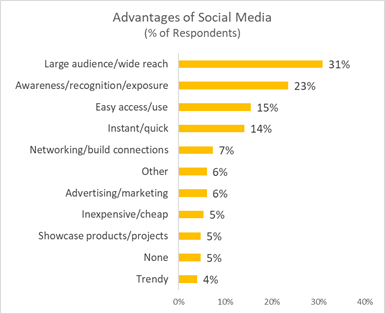 Sample Verbatim Comments
Sample Verbatim Comments
- Easy stories to get recognition.
- Good way to feature new products or provide images of recent projects.
- Good way to get your name and projects out there.
- Helps connect you with people outside the normal reach.
- Remind companies/clients you exist.
- Share and get information quickly with a broad audience.
- Social media provides more connections over a broader range.
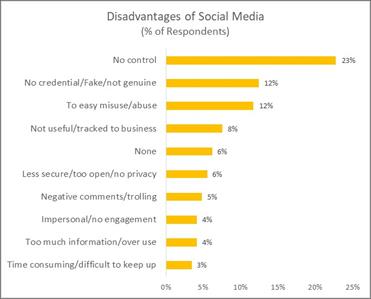 Looking at what building professionals perceive to be the disadvantages of social media also provides insight on how companies can better manage and maintain their social media. Most often, building professionals felt there was no control over what was posted in social media and much of it is not credible or is fake. This indicates that manufacturers should do everything in their power to generate social media posts with legitimate references, contacts or information. For example, just don’t promote that your product is durable or performs well. Provide facts and examples of the durability or performance. Give specific projects or firms that had success using the product or material or testimonials from facilities who have had success. Also, provide direct links or easy to reach contact information.
Looking at what building professionals perceive to be the disadvantages of social media also provides insight on how companies can better manage and maintain their social media. Most often, building professionals felt there was no control over what was posted in social media and much of it is not credible or is fake. This indicates that manufacturers should do everything in their power to generate social media posts with legitimate references, contacts or information. For example, just don’t promote that your product is durable or performs well. Provide facts and examples of the durability or performance. Give specific projects or firms that had success using the product or material or testimonials from facilities who have had success. Also, provide direct links or easy to reach contact information.
One of the complaints about social media that it is not easy to measure its impact or success. To provide some measurements, manufacturers can put information in their posts, blogs or other social media to measure their awareness and engagement. For example, putting in specific product links or contact forms that can be tracked. For example, recently AIM did research on measuring the effectiveness of a client’s advertising campaign. The case study, Does Print Advertising Work in a Digital Age?[3] demonstrated how Interline Creative Group (AIM’s sister company), used their proprietary IP Reverse Lookup Code for the client’s website. This code is placed on a website on each page and tracks visitors’ IP addresses and their journey as they consume data. Unique codes were then placed on the advertisements to track incoming visitors from a specific publication to the website. AIM was able to document each company and their visits based on the tracking code from the advertisement in the publication. Over 500 unique companies arrived as a result of the advertisements.
Since a frequent complaint about social media is that it can be fake, incorrect or negative, companies should work hard to present only true and factual information. In addition, they should continually monitor their company’s social media across all platforms to address any concerns or incorrect information floating out on the web.
How Companies Can Improve their Social Media Platform
When AIM asked building professionals specifically how companies could improve in their social media program in open-ended comments, respondents had a variety of suggestions. First and foremost, the information should be factual and relevant. Again, what is relevant to an architect or designer may not be relevant to a facility manager. Keep the information brief and simple. Provide contact information for professionals to get questions answered or to request more technical details. In addition, the social media should contain direct links, be easy to use and be current. Building professionals like to keep informed on new products so companies should highlight “new” content and showcase new products.
| Improvements (Open-Ended) | % Of Respondents |
| Factual/relevant information | 22% |
| Add direct link to post/communication | 14% |
| Websites/SM: Easy to use | 10% |
| Photos/product in use | 9% |
| Websites: Updated/current | 9% |
| Notice of new content/product info | 7% |
Sample Comments
- Having clear contact information to talk to a live person would be helpful. Social media is great to see new products but then it almost always requires talking to a person to follow up for more information and to find out how said product can work in the project I am working on.
- I actually find social media to be far less intrusive than the insane amount of emails that I receive from manufacturers. I would make sure information is current and relevant.
- Just keep new information coming up and keep website updated.
- Keep updating the quality of content and realistic appearance of their products online. Also, informative webinars and videos are very helpful.
- Keep websites up to date and easy to navigate to find technical information. Keep contacts on websites up to date and actually respond when contacted.
- Less is more. Quick hits of information with links versus drawn-out posts.
- Provide access to more technical information, which is currently more difficult to find among the marketing materials.
- Provide useful reports and information to supplement usual postings.
- They can make their social media simple and user friendly by adding all information to their bio such as website to view their products.
- Use links and posts to direct me to the right products and services I’m looking for. Be active on the platform.
Use Audience Feedback to Help Focus Social Media Strategy
Knowing exactly what the target audience needs and in what format it should be delivered is always challenging. The social and digital marketplace is constantly changing and to be successful, marketers need to stay current with what interests their target audience. To determine what the best social media is to reach building professionals, companies should be continuously conducting research with their key target audience. If you do not understand what is easy to use or the most “relevant” to the building professional audience, AIM suggests conducting research before developing your social media strategy. Find out what topics/type of product information is important to your audience and what details and contact information will be most helpful.
Another way to gain feedback from the target audience is through product reviews and ratings. Consumers of products rely more and more on product reviews and ratings. According to a report published by LinkedIn, The Rise of B2B Product Reviews[4], today B2B buyers rely more than ever on product reviews and feedback from their trusted network when making purchase decisions. In fact, 95% of consumers rely on reviews and product ratings before purchasing a product. It is important for B2B companies to encourage product reviews and testimonials on their website or in their social media platforms. Building professionals, like most B2B purchasers, are looking for products that fit their particular need or can solve a specific problem in their project or facility.
Building Professionals’ Use of Social Media is Here to Stay
Depending on the type of social media, AIM’s research showed that the majority of building professionals will most likely use social media either more or at about the same level over the next two years. In fact, over 50% of respondents indicated their use of social networking sites (i.e. Linkedin, Facebook,etc.) and photo sharing sites (i.e. Instagram, Snapchat, etc). would increase over the next few years. While using social media can be complicated and require B2B companies to continuously monitor and update their social media program, it is certain that social media will continue to impact B2B marketing, possibly forever.
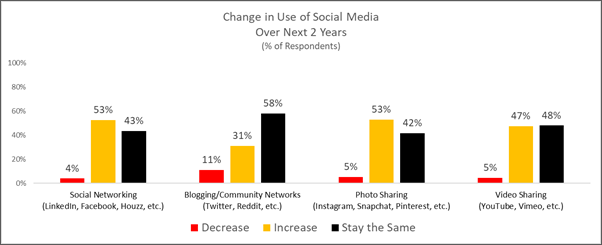 Not only do building professionals use social media to highlight their own businesses, but they use it to look for product information, network with peers, communicate with vendors and look for solutions or ideas for their project/facilities. While some building professionals do not see the value of social media, more and more are using it on a regular basis.
Not only do building professionals use social media to highlight their own businesses, but they use it to look for product information, network with peers, communicate with vendors and look for solutions or ideas for their project/facilities. While some building professionals do not see the value of social media, more and more are using it on a regular basis.
Sample Comments
- All of these social media sites will increase in use along with new sites arriving as well. The younger generations have grown up using these sites and their personal use will merge into business. As they become the dominant group in the workforce social media use will increase.
- We plan to integrate more videos into our social media.
- Our company needs to further address the use of this medium.
- Photo and project information sharing will be done mainly on specific cloud locations.
- More and more companies seem to be jumping into social media. A lot of products we specify are on these platforms.
- There has been a large increase in our firm with digital connection to clients and the design community.
All B2B companies should have some presence in social media. Since a company’s website is one of the most important marketing tools for reaching and engaging building professionals, the site should be constantly updated and be linked to the social media channels that are most frequently used by their target audience. With a constantly changing social and digital marketplace, it is essential for companies to review and adjust their social media strategy regularly. Based on AIM’s research, the most important aspect of any social media communication is to be useful and relevant to their audience. B2B social media should also be able to address and solve problems of a multitude of different audiences. Using product reviews, ratings, or testimonials as part of any social communication is also a great way to provide useful product information and also keep the target audience engaged.
[1] Research conducted by Zippia titled 30 Surprising Social Media At Work Statistics [2022]: What Every Manager Should Know, December 2021, https://www.zippia.com/advice/social-media-at-work-statistics/
[2] Smarter Building Materials Marketing, 3 Tips for Building Product Manufacturers To Increase Specifications, Podcast Episode 131, Venveo. https://www.venveo.com/podcast/3-tips-for-building-product-manufacturers-to-increase-specifications
[3] Does Print Advertising Work in a Digital Age?, Accountability Information Management case study, May 2022. https://www.a-i-m.com/case-studies
[4] The Rise of B2B Product Reviews report by LinkedIn provides a guide on How B2B Marketers can leverage Customer Voices to Drive Relevance and Revenue, https://business.linkedin.com/content/dam/me/business/en-us/marketing-solutions/resources/pdfs/linkedin-crowd-b2b-product-review-book.pdf